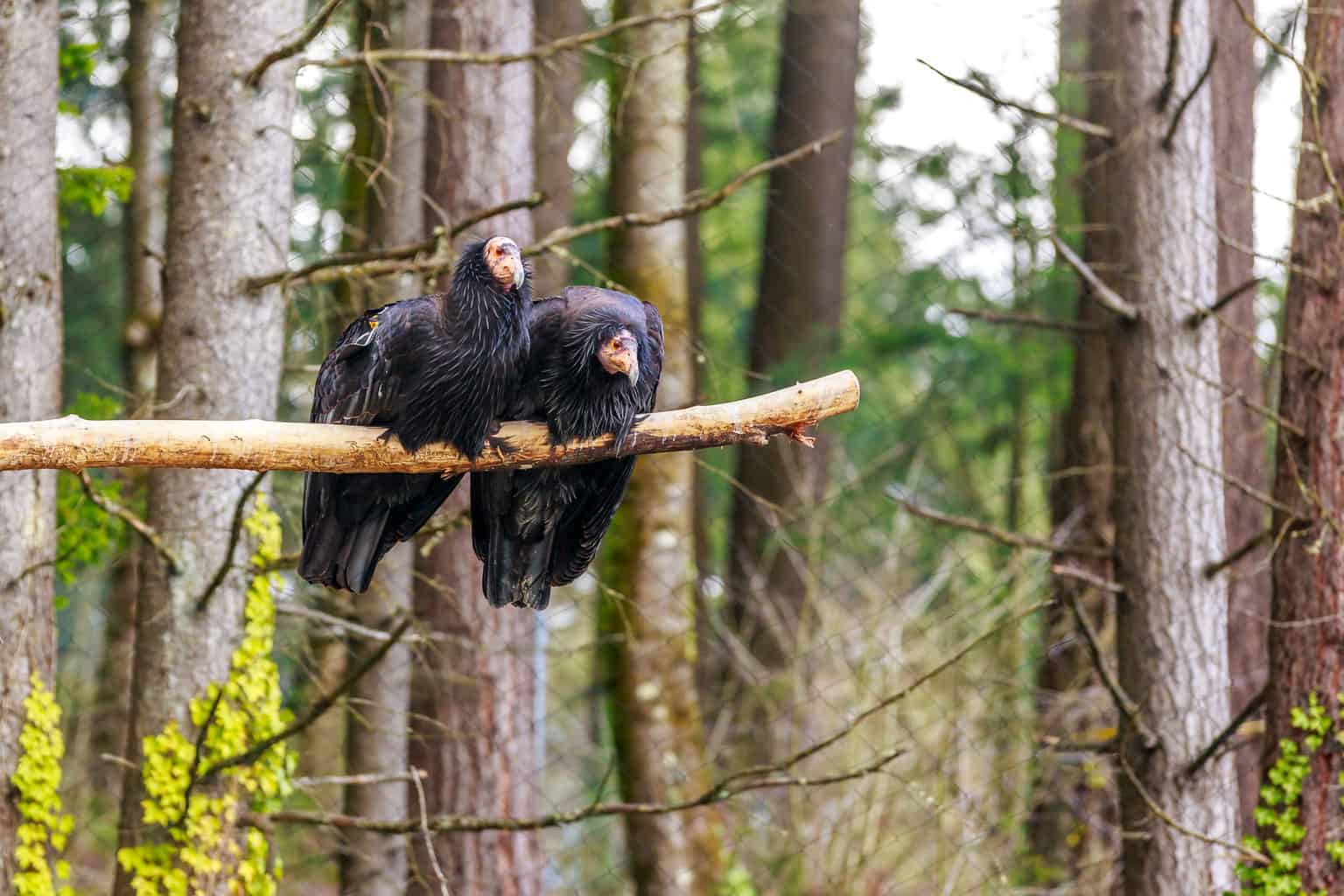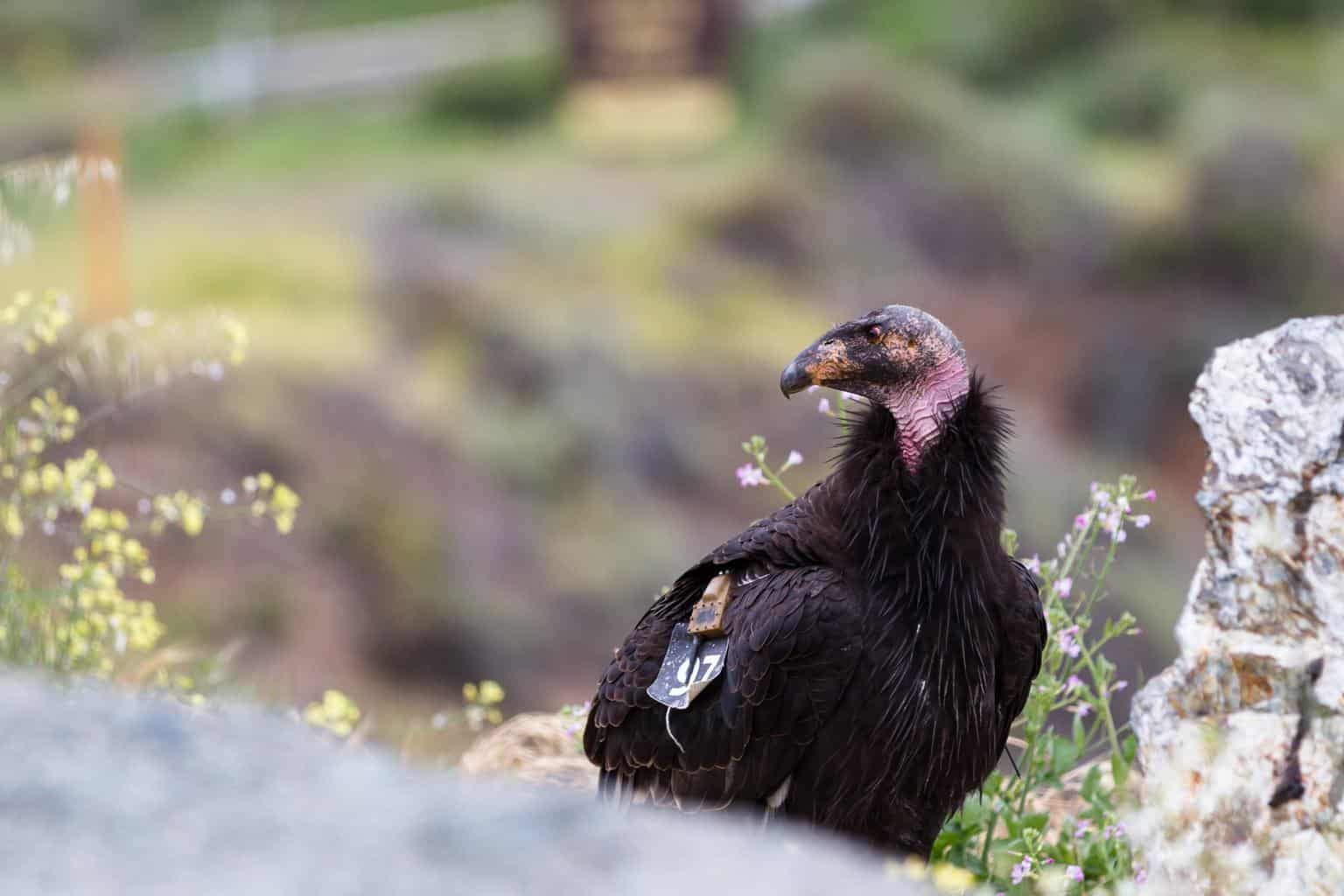The California condor (Gymnogyps californianus) holds several claims to fame among North American birds.
Not only is it the largest land bird in North America, but it’s also one of the rarest residents, and is considered a living relic of the Gymnogyps family that was once much more widespread across America and beyond.
Let’s take a closer look at the California condor, an enormous scavenger, recovering from the brink of extinction.
California Condor Appearance
The California condor is a huge, black bird with white patches on the undersides of its wings.
Its head is bald which keeps it clean when feeding on carcasses, and the skin color depends upon the age and condition of the bird.
While young birds typically have fairly grayish heads, adult condors can exhibit yellow, pink, and even deep red skin depending on the breeding season and even the emotional state of the bird.
California condors also have very striking ruby-red eyes.
California Condor Size
The California condor’s wingspan can reach a staggering 9ft 10 inches (3 meters) – larger than any other bird in North America.
Untypically for a bird of prey, males are larger than females. Its total length ranges from 43-55 inches (109-140cm), and its average weight is estimated at around 15-31 lb.
This length and weight are surpassed in North America by just two water birds – the trumpeter swan and the introduced mute swan.
Flying at altitudes of up to 15,000 feet these huge birds can be mistaken for a distant airplane!
What Does the Californian Condor Sound Like?
Wild condors are typically silent birds, but will sometimes make grunting, hissing sounds when competing with other scavengers on a carcass.
California Condor Lifespan

California condors are one the longest-lived birds in the world.
The oldest specimen in captivity named ‘Topa-topa’ has lived for over 50 years in captivity, and experts estimate that wild birds could live for over 60 years in age.
California Condor Range and Habitat
California condors are an ancient keystone species and used to soar the skies from Mexico to Canada, from the Pacific to the Atlantic Ocean. Their favorite habitats are rocky shrubland, coniferous forest, and oak savanna. They usually nest on cliff ledges or large trees.
In more recent centuries, their dwindling population became confined to the West Coast of the USA and was made temporarily extinct in the wild in 1987 when all remaining birds were captured in a bid to breed them in captivity.
The breeding and reintroduction program has proved remarkably successful. Today more than 300 condors can be found in the wild at Big Sur, Pinnacles National Park, Bitter Creek National Wildlife Refuge, and around the Vermilion Cliffs release site in Arizona near the Grand Canyon.
There have also been successful releases at the Sierra de San Pedro Mártir National Park, Baja California, Mexico.
California Condor Migration
Wild populations of California condors don’t migrate, but they do fly enormous distances in search of food.
It’s not unusual for them to travel for 160 miles a day in search of the carrion on which they depend.
California Condor Diet
California condors are rather like huge vultures – they only feed on dead animals, rather than killing their prey and are therefore classed as scavengers.
They prefer to feed upon the carcasses of larger animals such as deer, goats, horses, pigs, cougars, and bears, but will occasionally also take advantage of smaller offerings like rabbits and squirrels.
In the wild, they sometimes go up to two weeks without food, then gorge themselves on whatever they find. It’s not unusual for them to eat over 3 lb of meat in a single sitting!
They can usually scare away other scavengers from a kill, except for the mightiest competitors such as golden eagles and bears!
California Condor Conservation Status

Despite the success of captive breeding programs, the California condor remains one of the rarest birds in the world and is therefore considered critically endangered by the IUCN.
Once reduced to just 27 individuals, these ancient birds now number more than 500 when captive and wild birds are combined.
The slow speed of their recovery is partly due to their very slow breeding rate. California condors only begin reproducing at the age of seven and only raise one chick every two years.
To the elation of those involved in the conservation initiative, California condors began breeding in the wild again in 2003. By 2015 several breeding pairs meant that more California condors were born in the wild than those recorded dead.
California Condor FAQs
What Is the Largest Condor in the World?
With a wingspan of 10 feet and 10 inches, the Andean condor is not only the largest condor but the largest bird of prey in the world. Its wingspan is an entire foot bigger than its giant North American relatives!
What Are the Greatest Threats to Wild California Condors?
Although reintroduction programs have been fairly successful, wild birds still sometimes die prematurely.
Lead poisoning from dead game and the ingestion of trash such as plastics are the greatest killers of California condors today.
What Can I Do to Help Protect California Condors?
Firstly, taking home your garbage and encouraging others to do so is a great way to prevent condors from ingesting harmful human waste products.
Secondly, since lead poisoning from hunter’s ammunition is the leading cause of death in California condors, campaigning for an outright ban on lead shots is the best way we can protect these precious birds.
Find out more at huntingwithoutlead.org

